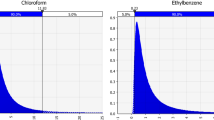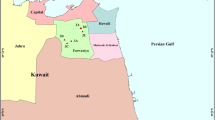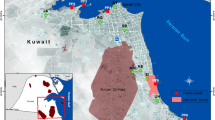Abstract
Indoor and ambient concentrations of 21 volatile organic compounds (including 14 hazardous air pollutants) were measured in the homes of nearly 80 western Montana (Missoula) high school students as part of the ‘Air Toxics Under the Big Sky’ program during the 2004/2005 and 2005/2006 school years. Target analytes were measured using low flow air sampling pumps and sorbent tubes, with analysis of the exposed samples by thermal desorption/gas chromatography/mass spectrometry (TD/GC/MS). The results reported here present the findings of the first indoor/ambient air toxics monitoring program conducted in a semi-rural valley location located in the Northern Rocky Mountain/Western Montana region. Of all of the air toxics quantified in this study, toluene was found to be the most abundant compound in both the indoor and ambient environments during each of the two school years. Indoor log-transformed mean concentrations were found to be higher when compared with ambient log-transformed mean concentrations at P<0.001 for the majority of the compounds, supporting the results of previous studies conducted in urban areas. For the air toxics consistently measured throughout this program, concentrations were approximately six times higher inside the student’s homes compared to those simultaneously measured directly outside their homes. For the majority of the compounds, there were no significant correlations between indoor and ambient concentrations.
Similar content being viewed by others
References
Adams, E., Ward, T. J., Vanek, D., Marra, N., Smith, G., Jones, D., et al. (2008). Air toxics under the Big Sky—A high school science teaching tool. Journal of Chemical Education, 85(2), 221–224.
Adgate, J. L., Church, T. R., Ryan, A. D., Ramachandran, G., Fredrickson, A. L., Stock, T. H., et al. (2004). Outdoor, indoor, and personal exposure to VOCs in children. Environmental Health Perspectives, 112(14), 1386–1392.
Fishbein, L., & Henry, C. J. (1991). Introduction: Workshop on the methodology for assessing health risks from complex mixtures in indoor air. Environmental Health Perspectives, 95, 3–5.
Gordon, S. M., Callahan, P. J., Nishioka, M. G., Brinkman, M. C., O’Rourke, M. K., Lebowitz, M. D., et al. (1999). Residential environmental measurements in the National Human Exposure Assessment Survey (NHEXAS) pilot study in Arizona: Preliminary results for pesticides and VOCs. Journal of Exposure Analysis and Environmental Epidemiology, 9(5), 456–470.
Helmig, D., & Greenburg, J. P. (1994). Automated in situ gas chromatographic-mass spectrometric analysis of ppt level volatile organic trace gases using multistage solid-adsorbent trapping. Journal of Chromatography A, 677, 123–132.
Jenkins, P. L., Phillips, T. J., Mulberg, J. M., & Hui, S. P. (1992). Activity patterns of Californians: Use of and proximity to indoor pollutant sources. Atmospheric Research, 26A, 2141–2148.
Kim, Y. M., Harrad, S., & Harrison, R. M. (2002). Levels and sources of personal inhalation exposure to volatile organic compounds. Environmental Science & Technology, 36, 5405–5410.
Kinney, P. L., Chillrud, S. N., Ramstrom, S., Ross, J., & Spengler, J. D. (2002). Exposures to multiple air toxics in New York City. Environmental Health Perspectives, 110(suppl 4), 539–546.
Payne-Sturges, D. C., Burke, T. A., Breysse, P., Diener-West, M., & Buckley, T. J. (2004). Personal exposure meets risk assessment: A comparison of measured and modeled exposures and risks in an urban community. Environmental Health Perspectives, 112(5), 589–598.
Phillips, M. L., Esmen, N. A., Hall, T. A., & Lynch, R. (2005). Determinants of exposure to volatile organic compounds in four Oklahoma cities. Journal of Exposure Analysis and Environmental Epidemiology, 15, 35–46.
Pratt, G. C., Wu, C. Y., Bock, D., Adgate, J. L., Ramachandran, G., Stock, T. H., et al. (2004). Comparing air dispersion model predictions with measured concentrations of VOCs in urban communities. Environmental Science & Technology, 38, 1949–1959.
Robinson, J., & Nelson, W. C. (1995). National human activity pattern survey data base. Research Triangle Park, NC: US Environmental Protection Agency.
Sexton, K., Adgate, J. L., Mongin, S. J., Pratt, G. C., Ramachandran, G., Stock, T. H., et al. (2004a). Evaluating differences between measured personal exposures to volatile organic compounds and concentrations in outdoor and indoor air. Environmental Science & Technology, 38, 2593–2602.
Sexton, K., Adgate, J. L., Ramachandran, G., Pratt, G. C., Mongin, S. J., Stock, T. H., et al. (2004b). Comparison of personal, indoor, and outdoor exposures to hazardous air pollutants in three urban communities. Environmental Science & Technology, 38, 423–430.
Sexton, K., Kleffman, D. E., & Callahan, M. A. (1995). An introduction to the National Human Exposure Assessment Survey (NHEXAS) and related Phase I field studies. Journal of Exposure Analysis and Environmental Epidemiology, 5(3), 229–232.
Skoog, D. A., Holler, J. F., & Nieman, T. A. (1998). Principles of instrumental analysis. Orlando: Harcourt Brace.
Sweet, C. W., & Vermette, S. J. (1992). Toxic volatile organic compounds in urban air in Illinois. Environmental Science & Technology, 26, 165–173.
Wallace, L. (1987). The total exposure assessment methodology (TEAM) study: Summary and analysis (vol. 1). Washington, DC: U.S. Environmental Protection Agency.
Ward, T. J. (2001). Chemical mass balance (CMB) source apportionment and organic speciation of PM 2.5 in Missoula, Montana including the 2000 wildfire season. Ph.D. Thesis, The University of Montana, Missoula, MT, USA.
Ward, T. J., Hamilton, R. F., & Smith, G. C. (2005). The Missoula Valley semivolatile and volatile organic compound study—Seasonal average concentrations. Journal of the Air & Waste Management Association, 55, 1007–1013.
Weisel, C. P. (2002). Assessing exposure to air toxics relative to asthma. Environmental Health Perspectives, 110(suppl 4), 527–537.
Woolfenden, E. (1997). Monitoring VOCs in air using sorbent tubes followed by thermal desorption-capillary GC analysis: Summary of data and practical guidelines. Journal of the Air & Waste Management Association, 47, 20–36.
Wrobel, C. L. (2000). Investigating volatile organic compounds in an urban inter-mountain valley using a TD/GC/MS methodology and intrinsic tracer molecules. Ph.D. Thesis, The University of Montana, Missoula, MT, USA.
Author information
Authors and Affiliations
Corresponding author
Rights and permissions
About this article
Cite this article
Ward, T.J., Underberg, H., Jones, D. et al. Indoor/ambient residential air toxics results in rural western Montana. Environ Monit Assess 153, 119–126 (2009). https://doi.org/10.1007/s10661-008-0342-2
Received:
Accepted:
Published:
Issue Date:
DOI: https://doi.org/10.1007/s10661-008-0342-2




